The Berlin Wall was both the physical division between West Berlin and East Germany from 1961 to 1989 and the symbolic boundary between democracy and Communism during the Cold War.
The Berlin Wall was erected in the dead of night and for 28 years kept East Germans from fleeing to the West. The fall of the Berlin Wall happened nearly as suddenly as its rise. On the evening of November 9, 1989, an announcement made by East German government official Günter Schabowski stated, “Permanent relocations can be done through all border checkpoints between the GDR (East Germany) into the FRG (West Germany) or West Berlin.” Crowds of euphoric East Germans crossed and climbed on to the wall in celebration. Soon the wall was gone and Berlin was united for the first time since 1945. “Only today,” one Berliner spray-painted on a piece of the wall, “is the war really over.”
———————————————————————————————————
Browse Berghahn relevant titles:
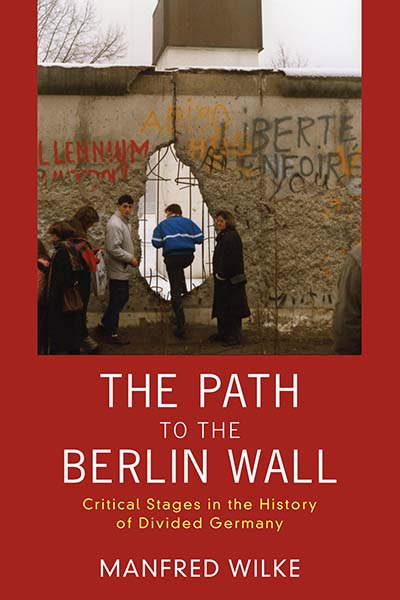 THE PATH TO THE BERLIN WALL
THE PATH TO THE BERLIN WALL
Critical Stages in the History of Divided Germany
Manfred Wilke
Translated from the German by Sophie Perl
“…constitutes a superlative model of combining biography with the study of nationalism. The latter constitutes the most novel contribution of this well-researched, straightforward historical depiction of Kohl’s ideology and its impact upon the continuing development of German national identity… Recommended” · Choice
The long path to the Berlin Wall began in 1945, when Josef Stalin instructed the Communist Party to take power in the Soviet occupation zone while the three Western allies secured their areas of influence. When Germany was split into separate states in 1949, Berlin remained divided into four sectors, with West Berlin surrounded by the GDR but lingering as a captivating showcase for Western values and goods. Following a failed Soviet attempt to expel the allies from West Berlin with a blockade in 1948–49, a second crisis ensued from 1958–61, during which the Soviet Union demanded once and for all the withdrawal of the Western powers and the transition of West Berlin to a “Free City.” Ultimately Nikita Khrushchev decided to close the border in hopes of halting the overwhelming exodus of East Germans into the West.
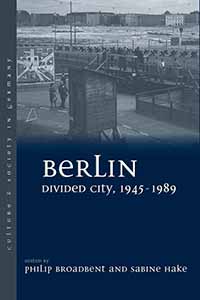
In Paperback!
BERLIN DIVIDED CITY, 1945-1989
Edited by Philip Broadbent and Sabine Hake
Volume 6, Culture & Society in Germany Series
“Eschewing the primacy of political history, the authors provide a nuanced picture of a city that, in many respects, was less divided than the Cold War mindset would have us believe…This interesting volume demonstrates the many ways in which East and West Berlin were mutually influential, and how commonalities extended beyond the division.” · English Historical Review
This volume examines how the city was conceived, perceived, and represented during the four decades preceding reunification and thereby offers a unique perspective on divided Berlin’s identities. German historians, art historians, architectural historians, and literary and cultural studies scholars explore the divisions and antagonisms that defined East and West Berlin; and by tracing the little studied similarities and extensive exchanges that occurred despite the presence of the Berlin Wall, they present an indispensible study on the politics and culture of the Cold War.
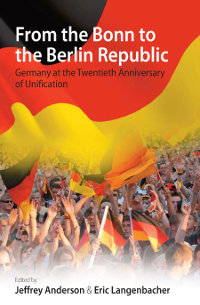 FROM THE BONN TO THE BERLIN REPUBLIC
FROM THE BONN TO THE BERLIN REPUBLIC
Germany at the Twentieth Anniversary of Unification
Edited by Jeffrey Anderson and Eric Langenbacher
“Altogether the contributions make for informative reading. The volume poses clear questions about the state of inner-German unity, and about the extent to which globalization, Europeanization, and the Cold War have changed the country.” · German Studies Review
The fall of the Berlin Wall and the unification of East and West Germany in 1989/90 were events of world-historical significance. The twentieth anniversary of this juncture represents an excellent opportunity to reflect upon the evolution of the new Berlin Republic. Given the on-going significance of the country for theory and concept–building in many disciplines, an in-depth examination of the case is essential. In this volume, unique in its focus on all aspects of contemporary Germany – culture, historiography, society, politics and the economy – top scholars offer their assessments of the country’s performance in these and other areas and analyze the successes and continued challenges.
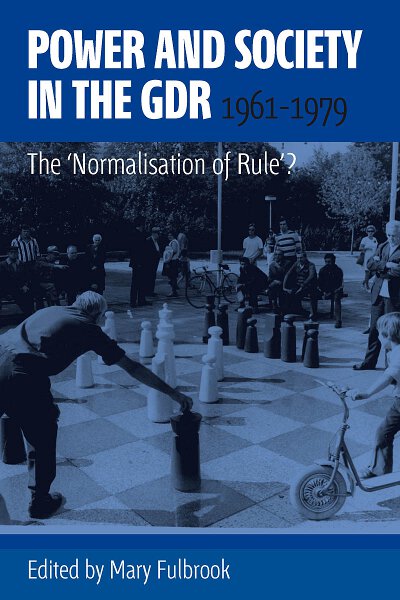
In Paperback!
POWER AND SOCIETY IN THE GDR, 1961-1979
The ‘Normalisation of Rule’?
Edited by Mary Fulbrook
“Mary Fulbrook produces high-quality works, and Power and Society in the GDRis no exception. She has assembled a strong collection of essays that examine the concept of normalization in East Germany during the stable middle decades…Altogether, [this] is an excellent book, one that has two major strengths. The first strength is the writing; every piece is very well-written. The second strength is how well the authors utilized their sources. They conscientiously engaged existing secondary scholarship in the text of their contributions.” · German Studies Review
By exploring the ways in which lower-level functionaries and people at the grass roots contributed to the formation and transformation of the GDR from industry and agriculture, through popular sport and cultural life, to the passage of generations and varieties of social experience the contributors collectively develop a more complex approach to the history of East Germany.
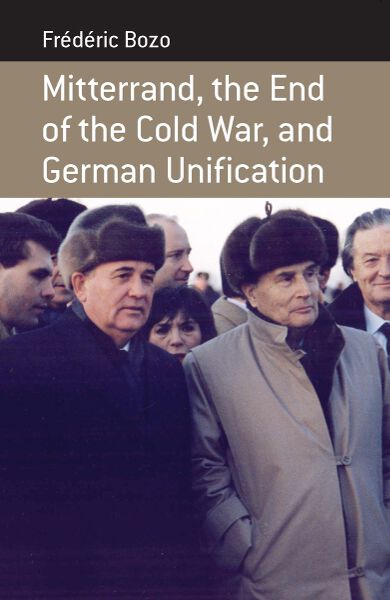
In Paperback!
CHOICE OUTSTANDING ACADEMIC TITLE 2010
MITTERRAND, THE END OF THE COLD WAR, AND GERMAN UNIFICATION
Frédéric Bozo
Translated from the French by Susan Emanuel
Volume 9, Berghahn Monographs in French Studies Series
“…a superb collection…a unique and valuable contribution to the voluminous literature on the Cold War. Essential.” · Choice
Twenty years after the fall of the Berlin Wall, this important book explores the role of France in the events leading up to the end of the Cold War and German unification. Most accounts concentrate on the role of the United States and look at these events through the bipolar prism of Soviet-American relations. Yet because of its central position in Europe and of its status as Germany’s foremost European partner, France and its President, François Mitterrand, played a decisive role in these pivotal international events: the peaceful liberation of Eastern Europe from Soviet rule starting in 1988, the fall of the Berlin Wall and Germany’s return to unity and full sovereignty in 1989/90, and the breakup of the USSR in 1991. Based on extensive research and a vast amount of archival sources, this book explores the role played by France in shaping a new European order.
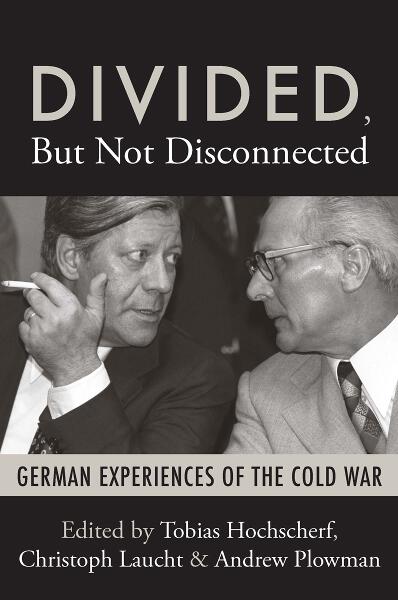
In Paperback!
DIVIDED, BUT NOT DISCONNECTED
German Experiences of the Cold War
Edited by Tobias Hochscherf, Christoph Laucht, and Andrew Plowman
The Allied agreement after the Second World War did not only partition Germany, it divided the nation along the fault-lines of a new bipolar world order. This inner border made Germany a unique place to experience the Cold War, and the “German question” in this post-1945 variant remained inextricably entwined with the vicissitudes of the Cold War until its end. This volume explores how social and cultural practices in both German states between 1949 and 1989 were shaped by the existence of this inner border, putting them on opposing sides of the ideological divide between the Western and Eastern blocs, as well as stabilizing relations between them. This volume’s interdisciplinary approach addresses important intersections between history, politics, and culture, offering an important new appraisal of the German experiences of the Cold War.
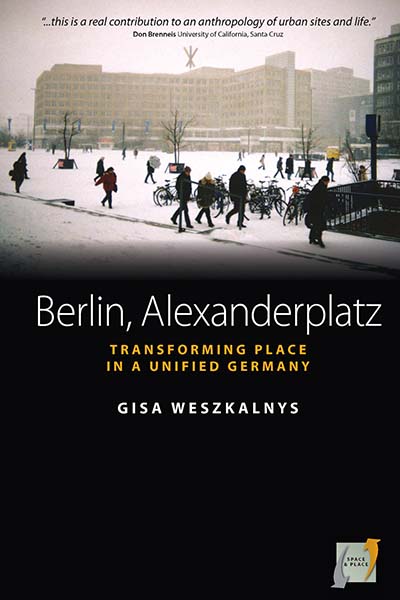 New in Paperback!
New in Paperback!
BERLIN, ALEXANDERPLATZ
Transforming Place in a Unified Germany
Gisa Weszkalnys
Volume 1, Space and Place
“Weszkalnys undertakes a fascinating exploration of the planning process, the intellectual debate and political contest over reconstruction, and the multiple roles of citizenship in the reunified city.” · H-Net Reviews
A benchmark study in the changing field of urban anthropology, Berlin, Alexanderplatz is an ethnographic examination of the rapid transformation of the unified Berlin. Through a captivating account of the controversy around this symbolic public square in East Berlin, the book raises acute questions about expertise, citizenship, government and belonging. Based on ethnographic fieldwork in the city administration bureaus, developers’ offices, citizen groups and in Alexanderplatz itself, the author advances a richly innovative analysis of the multiplicity of place. Alexanderplatz emerges as a socialist spatial exemplar, a ‘future’ under construction, an object of grievance, and a vision of robust public space. This book is both a critical contribution to the anthropology of contemporary modernity and a radical intervention in current cross-disciplinary debates on the city.
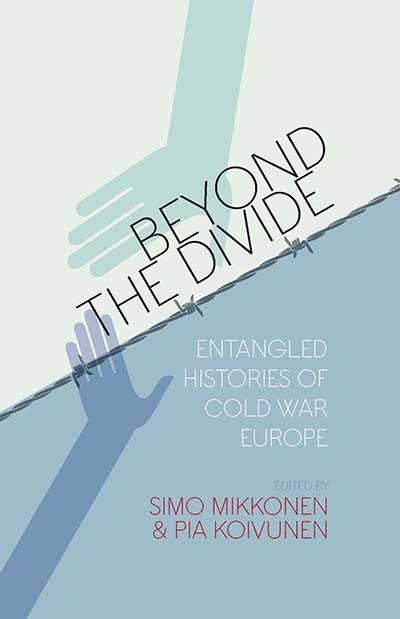
NEW!
BEYOND THE DIVIDE
Entangled Histories of Cold War Europe
Edited by Simo Mikkonen and Pia Koivunen
Cold War history has emphasized the division of Europe into two warring camps with separate ideologies and little in common. This volume presents an alternative perspective by suggesting that there were transnational networks bridging the gap and connecting like-minded people on both sides of the divide. Long before the fall of the Berlin Wall, there were institutions, organizations, and individuals who brought people from the East and the West together, joined by shared professions, ideas, and sometimes even through marriage. The volume aims at proving that the post-WWII histories of Western and Eastern Europe were entangled by looking at cases involving France, Denmark, Poland, Romania, Switzerland, and others.
Read Introduction: Beyond the Divide
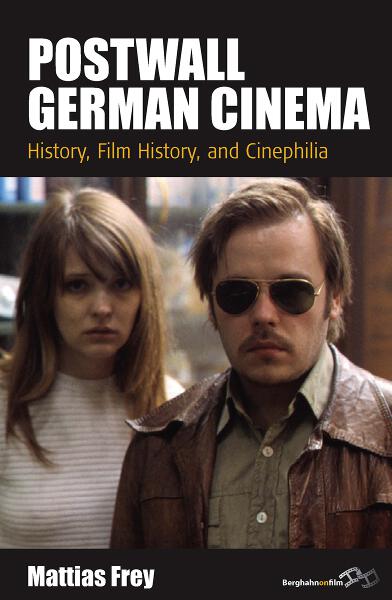
New in Paperback!
POSTWALL GERMAN CINEMA
History, Film History and Cinephilia
Mattias Frey
Volume 14, Film Europa Series
“…his highly original contribution to historiography reconsiders the ‘historical turn’ in recent German cinema, framing it as also indicative of a cinephilic reworking of the history of the cinema, effectively remediating previous filmic representations of history.” · Seminar: A Journal of Germanic Studies
Since the fall of the Berlin Wall, there has been a proliferation of German historical films. These productions have earned prestigious awards and scored at box offices both at home and abroad, where they count among the most popular German films of all time. Suddenly, however, a significant departure has been made from the country’s prominent cinematic take on history: the radical style, content, and politics of the New German Cinema. With in-depth analyses of the major trends and films, this book represents a comprehensive assessment of the historical film in postwall Germany. Challenging previous paradigms, it takes account of a postwall cinema of retro-flection as a complex engagement with various historiographical forms and, above all, with film history itself.
 In Paperback!
In Paperback!
POWER AND SOCIETY IN THE GDR, 1961-1979
The ‘Normalisation of Rule’?
Edited by Mary Fulbrook
The communist German Democratic Republic, founded in 1949 in the Soviet-occupied zone of post-war Germany is, for many people, epitomized by the Berlin Wall; Soviet tanks and surveillance by the secret security police, the Stasi, appear to be central. But is this really all there is to the GDR¹s history? How did people come to terms with their situation and make new lives behind the Wall? When the social history of the GDR in the 1960s and 1970s is explored, new patterns become evident. A fragile stability emerged in a period characterized by ‘consumer socialism’, international recognition and détente. Growing participation in the micro-structures of power, and conformity to the unwritten rules of an increasingly predictable system, suggest increasing accommodation to dominant norms and conceptions of socialist ‘normality’. By exploring the ways in which lower-level functionaries and people at the grass roots contributed to the formation and transformation of the GDR from industry and agriculture, through popular sport and cultural life, to the passage of generations and varieties of social experience the contributors collectively develop a more complex approach to the history of East Germany.
 In Paperback!
In Paperback!
FRIENDLY ENEMIES
Britain and the GDR, 1949-1990
Stefan Berger and Norman LaPorte
During the Cold War, Britain had an astonishing number of contacts and connections with one of the Soviet Bloc’s most hard-line regimes: the German Democratic Republic. The left wing of the British Labour Party and the Trade Unions often had closer ties with communist East Germany than the Communist Party of Great Britain (CPGB). There were strong connections between the East German and British churches, women’s movements, and peace movements; influential conservative politicians and the Communist leadership in the GDR had working relationships; and lucrative contracts existed between business leaders in Britain and their counterparts in East Germany. Based on their extensive knowledge of the documentary sources, the authors provide the first comprehensive study of Anglo-East German relations in this surprisingly under-researched field. They examine the complex motivations underlying different political groups’ engagement with the GDR, and offer new and interesting insights into British political culture during the Cold War.
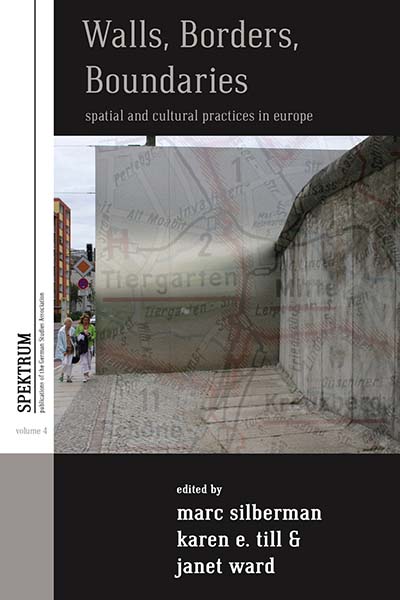
New in Paperback!
WALLS, BORDERS, BOUNDARIES
Spatial and Cultural Practices in Europe
Edited by Marc Silberman, Karen E. Till, and Janet Ward
Volume 4, Spektrum: Publications of the German Studies Association Series
“…a highly welcome and useful addition to… scholarship [that] brings together scholars from several academic fields, including history, geography, anthropology, and Germanistik, in a fruitful effort to promote interdisciplinary dialogue and cooperation… The book’s thoughtful and valuable contributions reach far beyond Berlin alone. Indeed, the multiplicity of approaches and perspectives in many ways enriches the book. The study deserves to reach a wide readership among scholars of a number of disciplines, and it is to be hoped that it will inspire further study of the themes and issues addressed here.” · German Studies Review
This edited volume explores the crossings, permeations, and constructions of cultural and political borders between peoples and territories, examining how walls, borders, and boundaries signify both interdependence and contact within sites of conflict and separation.
———————————————————————————————————
From Berghahn Journals:
German Politics and Society is a joint publication of the BMW Center for German and European Studies (of the Edmund A. Walsh School of Foreign Service, Georgetown University) and all North American universities featuring programs and centers of German and European studies associated with the German Academic Exchange Service (DAAD). These centers are represented by their directors on the journal’s Editorial Committee.
German Politics and Society is a peer-reviewed journal published and distributed by Berghahn Journals. It is the only American publication that explores issues in modern Germany from the combined perspectives of the social sciences, history, and cultural studies.
The journal provides a forum for critical analysis and debate about politics, history, film, literature, visual arts, and popular culture in contemporary Germany. Every issue includes contributions by renowned scholars commenting on recent books about Germany.

